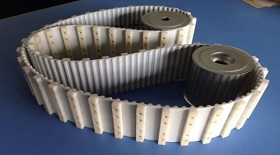Classification of synchronous belt
Synchronous belt teeth have trapezoidal teeth and arc teeth, and arc teeth have three series arc teeth (H series also known as HTD belt), flat top arc teeth (S series also known as STPD belt) and concave top parabolic teeth (R series).
T type Synchronous belt
The trapezoidal toothed synchronous belt is divided into two types, including one side and two sides. The double side belt is divided into symmetrical tooth type (code DA) and interlaced tooth type (code DB) according to the arrangement of teeth.
Trapezoidal tooth synchronization has two sizes: pitch and modulus. According to ISO 5296, the corresponding standards of synchronous belt drive GB/T 11361-11362-1989 and GB/T 11616-1989 have been worked out.
Arc tooth synchronous belt
The structure of arc tooth synchronous belt is basically the same as that of trapezoidal tooth synchronous belt except that the tooth shape is curved. The pitch of belt is the same. The tooth height, tooth root thickness and tooth root radius are larger than that of trapezoidal tooth. After loading, the stress distribution state of the belt teeth is better, the stress concentration of the tooth root is alleviated, and the bearing capacity of the tooth is improved. Therefore, the arc tooth synchronous belt has greater transmission power than the trapezoidal tooth synchronous belt, and can prevent the interference of teeth in the meshing process.
The arc tooth synchronous belt has good wear resistance, low noise and no need of lubrication. It can be used in harsh environment with dust. It has been widely used in food, automobile, textile, pharmaceutical, printing, paper-making and other industries.



